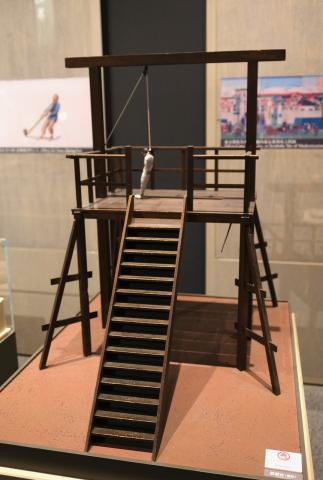Issue:
January 2025
The story of Japan’s first gallows … and the first foreigner to be executed
Hanging as a form of execution is believed to have originated in Persia (Iran). It was adopted in England as early as the 12th century, but it was not until the 19th century that James Berry, Yorkshire's executioner from 1884 to 1892, calculated a table of body weights that determined the falling distance (i.e., the distance it took for the rope to be made taut by the falling body) of from 1 to 10 feet. This system, described by one member of a Royal Commission as "quicker than shooting, and cleaner", was designed to fracture the cervical vertebrae (usually the fourth and fifth), rupturing the spinal cord and causing almost instantaneous death, as opposed to slow strangulation.
Due in part to Western influences of the times, Japan's authorities in the early Meiji era sought to make a clean break with decapitation by sword and considered other forms of capital punishment. New judicial guidelines introduced in December 1870 provided for adoption of a "strangulation pillar", a variation of the Spanish garotte. The condemned would be seated in a contraption with his back against a wooden pillar through which a rope was looped, with a heavy weight attached to the other end. The loop was placed around the neck of the condemned, and at a signal, the executioner allowed the weight to drop, leading to slow strangulation. This method was soon abandoned, and after having dispatched officials to observe the "long drop" gallows in use at the British colonies of Hong Kong and Singapore, Japanese became convinced hanging offered a swift and more humane means of execution. Thus on February 20, 1873, government Decree no. 65 prescribed the adoption of a gallows. Blueprints called for it to stand 3 meters in height with a hinged platform measuring 2.6 by 2 meters.

Japan's Bureau of Punishments invited bids to build the nation's first gallows. A carpenter named Hasegawa, who had performed construction jobs for the Home Ministry, reluctantly placed his bid.
"I thought I could probably do the whole job for ¥25 or so," Hasegawa recalled to a chronicler of contemporary events. "But it seemed rather distasteful work and I bid ¥120, thinking I would hardly land the job at that price. But I guess the other carpenters were thinking the same; they bid even higher, some as much as ¥150 or even ¥300 yen. Being the lowest, I got stuck with the job. Anyway, I figured there would be enough money left over for a night out on the town.”
"They told me they didn't want the condemned's neck to be mangled," Hasegawa continued, "so we wrapped hairs around the part of the rope that made contact with the neck, and on top of that we stitched a cover of deerskin. The rope was looped through a copper ring and secured to another ring on one of the pillars."
Even after the gallows were put into use, however, decapitation by sword continued to be carried out concurrently with hangings through the 1870s.
In 1900, an American seaman named Robert Miller became the first foreigner to be executed by hanging, for a triple murder in Yokohama's Chinatown.
If Miller had committed his crimes while extraterritoriality had still been in force in Yokohama foreign settlement, he would have been tried by a U.S. court. Extraterritoriality was imposed at treaty ports in China and Japan from the mid-19th century, when the Western powers were aghast at the draconian legal systems, in which "confessions" were frequently obtained through torture and due process was nonexistent, as was the right to appeal a conviction.
The practice of torture in Japan was not specifically banned until Article 36 of the U.S. imposed postwar constitution, which read: "The infliction of torture by any public officer and cruel punishments are absolutely forbidden." appeared in the postwar American-imposed Constitution.
Extraterritoriality, a key facet of the so-called "unequal treaties", gave foreign powers the right to try their own nationals accused of crimes. In China, it remained in effect until renounced by the U.S. and Great Britain on January 11, 1943.
In Japan, the treaty ports were Yokohama, Nagasaki, and Hakodate, all established in 1859, and some years later Osaka, Kobe, Tokyo and Niigata.
Extraterritoriality in Japan was abolished two years before the end of the 19th century. Foreign minister Shigenobu Okuma proposed a plan to hire Western justices at what was then called the Great Court of Cassation (currently the Supreme Court) to try their own nationals. The proposal was accepted by the U.S., which signed a revised treaty in February 1999, after which the other powers successively fell into line.
The new treaty came into effect on July 16, 1899, and was immediately put to the test the next day, when Miller, an unemployed 49-year-old seaman, was implicated in a triple slaying in Yokohama's Chinatown. The crime took place at a saloon-cum-brothel called The Rising Sun Inn, located diagonally across the road from the Guandi Temple. The street's nickname, "Blood Alley", reflected its notorious reputation as a place where sailors, when not drinking to excess and whoring, engaged in brawls.
Armed with a straight razor and claw hammer, Miller murdered an American named W. Nelson Ward, the saloon’s female proprietor Suye Tonooka (age 24) and an employee, Aki Suzuki (age 19).
The next morning a female employee named Tanaka, returning from an assignation the previous night, found the three bloodied bodies, and her screams soon brought the police, who searched the neighborhood. A momban (gatekeeper) at the settlement told them he saw Miller leaving The Rising Sun a little before 7 a.m., stopping at a hydrant to wash blood from his hands. Miller then entered Jim's Place, a nearby saloon, and demanded a drink.
At about 11 a.m., police went to the saloon and found Miller snoring away in an upstairs room. They shook him awake and arrested him.
Miller told his interrogators he had parted company with his ship, the Tam O'Shanter, the previous April, due to what he claimed was mistreatment by the ship's captain and mate that had partially crippled his right arm. With $60 in gold and another ¥100 in pay from his ship, he found a room in Chinatown. He performed a few odd jobs in the Honmoku shipyard, but began spending much of his time imbibing whiskey at The Rising Sun.
Miller and Ward, another disreputable character, had apparently been competing for the affections of Ms. Tonooka, hoping to conclude a marriage with her and take control of the saloon. Miller had followed his rival into the saloon, killed him with the razor, and then "in a fit of mad rage and jealousy" murdered the two women.
The Public Procurator, a judge of the Yokohama District Court and a court-appointed doctor conducted an inquest. By the afternoon, an American consular official, George H. Scidmore, came to identify Ward's body. Miller, manacled in handcuffs, was taken to the Public Procurator’s Office at 5 p.m. At a preliminary examination on July 18, he reportedly confessed to the crime. The same day, all three of his victims were cremated.
The Yorozu Choho newspaper reported Miller was incarcerated in one of the cells that had been newly prepared to accommodate foreign prisoners, a four-and-one-half-mat room with a bed, table and chair. In those times, a generous 20 sen a day was budgeted for prisoners’ meals, consisting of bread and sliced beef on a tin plate and barley tea. "When a warder or inspector comes in … [Miller] rises and salutes them," the newspaper reported. "Undoubtedly he has a large [sic] experience of prison life."
The trial sessions, which began on August 7, attracted a large number of curious spectators. Attorney Genzo Akiyama, a former jurist, represented the defendant. "He [Miller] is a man of low type," The Japan Weekly Mail described Miller as he stood in the dock, "with the dull eye and flabby cheek of a habitual drinker, a drooping moustache, and a beard of several days' growth. He has, however, the air of slouching self-assurance and slovenly smartness common to so many men of his type. He … seemed less interested in the case than many of the spectators."

In his defense, Miller claimed extenuating circumstances for his homicidal behavior, which had resulted, he insisted rather incredibly, from his having been served an inferior Japanese whiskey. His lawyer went so far as to apply for laboratory analysis of the hootch Miller imbibed just before his crime, to explore the feasibility of a temporary insanity plea.
That argument was dismissed out of hand, and on August 19, the court found Miller guilty of having murdered three persons and sentenced him to death. In a lengthy statement, the judges ruled: "It is the benevolent desire of His Imperial Majesty the Emperor that all strangers within our Empire should be treated with magnanimity, and it is also the wish of our people to extend kindness and hospitality to aliens resident in this land.
"At this juncture, when Japan has taken her place among the community of nations, and her legal autonomy has been restored, it is most distressing to the judicial officials to be placed under the painful necessity of sentencing a citizen of one of the Treaty Powers to death.
"The Court deems it most regrettable that in the pleading of the accused and the earnest arguments of his counsel, it is unable to discover any adequate grounds for defense."
While awaiting execution, Miller received weekly visits from Charles H. Evans, the senior priest of the American Church Mission in Japan. In a letter to The Japan Weekly Mail, Evans later wrote, “I was with [Miller] at the last … For a man whose life had been stained by almost every sin … and for one who had never known the meaning of religion, the sentiments uttered by him in the latter days of his life seem to show a great measure of repentance, with a true sorrow for his sins.”
After the Great Court of Cassation rejected the final appeal, Miller's lawyer petitioned the Emperor for leniency. The entreaty went unheeded. After thanking the staff of the jail for their kindness, Miller was transported by horse-drawn wagon to the prison in Ichigaya and on the morning of January 12, 1900, was served a hearty breakfast. He requested a last drink of alcohol, which was refused. Permission to smoke a last cigar was granted, however. The chaplin drew one from his pocket, and Miller lit up and took several contented puffs.
"When the cigar was only half smoked," wrote Harold S. Williams in Foreign Settlements in Japan, the Governor announced that time was up. A hood was pulled over Miller's head. His arms and feet were bound, and the noose tightened around his neck. The trap was sprung and … precisely eight minutes later the doctor declared him dead."
He was buried in an unmarked grave in Tokyo's Zoshigaya cemetery.
Japan's civilian criminal courts have since applied the death penalty to Westerners only on rare occasions. Another was Soviet agent Richard Sorge, whose wartime espionage activities will be covered in a future installment.
Mark Schreiber is the author of Shocking Crimes of Postwar Japan (Yenbooks, 1996) and The Dark Side: Infamous Japanese Crimes and Criminals (Kodansha International, 2001).





